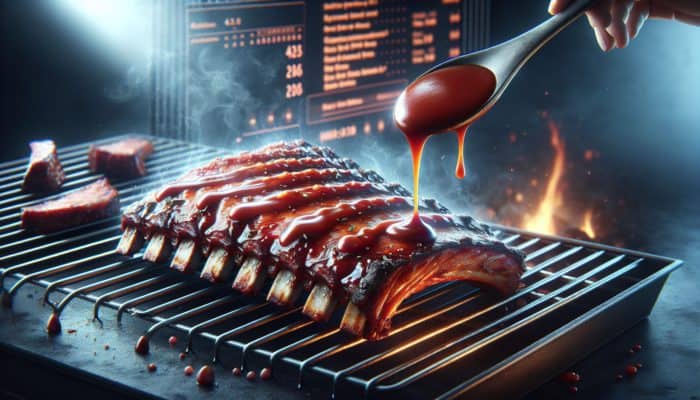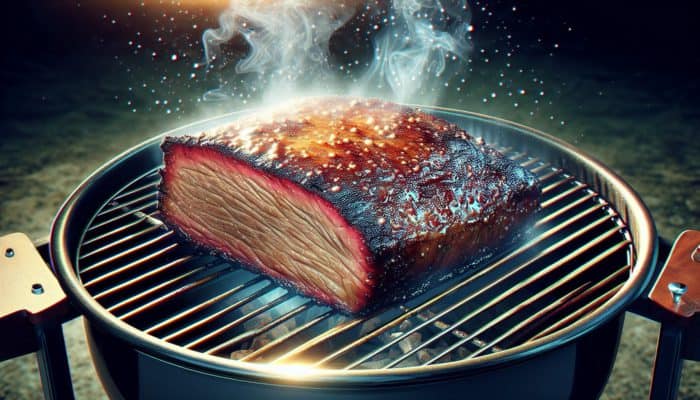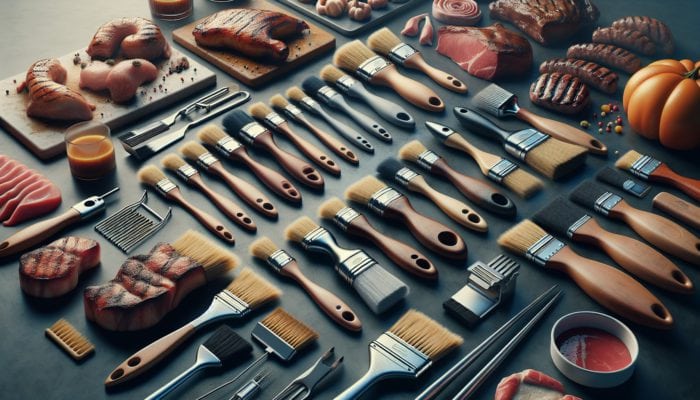Maximize Flavor: The Essential Role of Basting in American BBQ
What Benefits Does Basting Provide for Flavor Enhancement?

Basting is an indispensable technique in American BBQ that not only adds moisture but also amplifies the flavor of meats, substantially enhancing the overall taste of your culinary creations. When you engage in the basting process, you are not merely applying sauce; instead, you are forming a flavorful barrier that locks in the natural juices, ensuring the meat remains tender and succulent throughout the cooking journey. As the meat cooks, the application of heat melds the flavors of the basting liquid with the meat's juices, culminating in a rich and complex flavor profile that epitomizes exquisite BBQ.
Essential basting ingredients typically comprise:
- Barbecue sauce
- Olive oil or melted butter
- Apple cider vinegar
- Mustard
- Broth or stock
- Herbs and spices
- Citrus juices
- Honey or brown sugar for caramelization
These components not only enhance the flavor but also contribute to the overall moisture retention, preventing the meat from drying out during the cooking process, thus ensuring a delightful BBQ experience.
What Is the Importance of Basting Brushes in Culinary Preparation?
A basting brush is an indispensable tool in the BBQ toolkit, purposefully designed to evenly distribute sauces and marinades across the surface of various meats. Unlike simply pouring or spooning sauces, a basting brush guarantees that every inch of the meat is thoroughly coated, providing a consistent and delightful flavor throughout. The bristles of the brush enable the sauce to be applied in a thin layer, which is crucial for optimal cooking, as it allows for rapid absorption and mitigates excess buildup that could lead to charring.
Various types of basting brushes include:
- Silicone brushes for high-temperature grilling
- Bristle brushes for traditional basting
- Flat brushes for delicate sauce applications
- Marinade injectors for deeper flavor infusion
- Sponges for soaking and dabbing sauces
Selecting the appropriate brush can profoundly affect the efficiency and effectiveness of your basting process, significantly enhancing your overall BBQ experience.
How to Adapt Basting Techniques for Various Meats?
Different types of meats necessitate specific basting techniques to achieve the best results, as each cut responds uniquely to moisture and flavor. For example, while ribs benefit from frequent basting to develop a sticky glaze, briskets require a more methodical approach to retain moisture throughout the extended cooking process.
Here are tailored basting techniques for popular American meats:
- Ribs: Baste every 30 minutes with a blend of apple cider vinegar and BBQ sauce to create a rich glaze.
- Brisket: Utilize a mop sauce made with beef broth and spices, applying it every hour to maintain moisture.
- Pork shoulder: Baste with a mixture of mustard and vinegar to help form a flavorful crust.
- Chicken: Use butter or oil combined with herbs, basting every 15 minutes to achieve crispy skin.
- Turkey: Apply a mixture of broth and melted butter every 30 minutes to ensure juicy meat.
Mastering these techniques not only enhances flavor but also enriches the overall BBQ experience for everyone gathered at the table.
What Effect Does Basting Have on Cooking Time and Meat Texture?

Basting plays a critical role in influencing cooking time and the texture of meats, especially in American BBQ, where achieving the ideal balance of tenderness and juiciness is paramount. The act of basting introduces moisture and creates a protective layer, which can consequently reduce cooking times by preventing the meat from drying out. Thus, meats like brisket or pork shoulder, which typically require extended cooking durations, can retain their juiciness and tenderness with effective basting.
Here’s how basting impacts various meats:
- Ribs: Basting can shorten cooking time by up to 20%, yielding tender meat that easily pulls away from the bone.
- Brisket: Regular basting ensures a moist interior and helps prevent the outer layer from becoming tough.
- Chicken: Frequent basting maintains crispy skin while ensuring the meat stays juicy.
- Pork: Helps lock in moisture, resulting in a tender and flavorful finish.
Understanding these effects is vital for anyone looking to refine their BBQ technique and achieve optimal results.
Why Is Selecting a Quality Basting Brush Crucial for BBQ Success?
What Materials Make for the Best Basting Brushes?
The choice of material for a basting brush has a profound impact on its durability, performance, and suitability for various cooking methods. Common materials include silicone, boar hair, and nylon, each offering unique advantages for BBQ enthusiasts. Silicone brushes are heat-resistant and easy to clean, making them ideal for high-temperature grilling. Conversely, boar hair brushes provide excellent oil retention and are superb for applying marinades, though they require more care during cleaning.
A detailed analysis reveals:
- Silicone: Durable, non-stick, and withstands high temperatures effortlessly.
- Boar Hair: Exceptional for sauce application due to the natural flexibility of the bristles.
- Nylon: Cost-effective and suitable for lower temperature operations.
- Wooden Handles: Offer a classic feel but may necessitate more maintenance.
Choosing the right brush based on its material can significantly enhance your overall basting experience and lead to superior cooking results.
How Can You Select the Perfect Basting Brush for Your Cooking Style?

Selecting the ideal basting brush involves evaluating your cooking style and frequency of use. A practical starting point is to assess the types of meats you commonly prepare and the cooking methods you employ. For instance, if high-temperature grilling is your forte, a silicone brush would be an excellent choice due to its heat resistance. On the other hand, if you prefer traditional BBQ techniques, a natural bristle brush may be more suitable for your needs.
Here are actionable steps to guide your basting brush selection:
- Identify your primary cooking methods: grilling, smoking, or roasting.
- Consider the types of sauces you frequently use: thicker sauces might require stiffer bristles.
- Evaluate your cleaning preferences: silicone brushes are generally easier to clean than natural bristles.
- Assess your budget: higher-quality brushes may offer greater durability, justifying the investment.
By thoughtfully considering these factors, you can ensure that your basting brush aligns with your culinary needs.
Why Does the Quality of a Basting Brush Affect Cooking Results?
The quality of your basting brush can profoundly impact the outcome of your cooking. High-quality brushes ensure even application of sauces and marinades, which is crucial for achieving consistent flavor. Professional chefs often depend on their basting brushes to create signature dishes that stand out for their taste and presentation. A well-crafted brush not only enhances efficiency but also elevates the final presentation of your BBQ creations.
Real-world examples underscore the significance of quality:
- Professional pitmasters frequently choose brushes that can endure long hours over hot grills.
- Chefs utilize soft bristle brushes for delicate sauces requiring a gentle touch.
- Top-rated brushes withstand repeated washing without losing their shape or effectiveness.
- Numerous award-winning BBQ establishments attribute their flavor success to the use of high-quality basting tools.
Investing in a reliable basting brush is imperative for any passionate BBQ enthusiast aspiring to achieve restaurant-quality results at home.
What Maintenance Practices Ensure Longevity for Your Basting Brush?
Proper maintenance and cleaning of your basting brush are essential for prolonging its lifespan and ensuring it remains effective for many years. Different materials necessitate specific care; silicone brushes can often be washed in the dishwasher, while natural bristle brushes require gentler handling to prevent bristle damage. Routine cleaning eliminates the buildup of bacteria and ensures that flavors from previous cooking sessions do not contaminate your current dishes.
Cleaning techniques vary by type:
- Silicone brushes: Wash in warm, soapy water or place in the top rack of the dishwasher.
- Bristle brushes: Gently hand wash to preserve bristles and allow to air dry.
- Nylon brushes: Clean with warm water and mild soap; avoid exposure to high heat.
- Wooden handles: Wipe with a damp cloth and occasionally apply food-safe oil to prevent cracking.
By incorporating these cleaning routines, you can maintain your basting brush in optimal condition, ensuring it is always ready for your next BBQ adventure.
Why Is a Basting Brush Vital for BBQ Excellence?
How Can a Basting Brush Boost Cooking Efficiency?
Utilizing a basting brush significantly enhances cooking efficiency by facilitating quick and uniform application of sauces and marinades. This tool enables BBQ aficionados to coat meats swiftly without the mess associated with pouring or spooning, thereby reducing preparation time. The efficiency gained through basting brushes not only accelerates the cooking process but also optimizes flavor integration throughout the dish.
Consider these time-saving strategies:
- Pre-mix basting sauces in a bowl for easy access during cooking.
- Use a silicone brush for on-the-fly applications that can withstand high temperatures.
- Maintain multiple brushes for different sauces to prevent flavor contamination.
- Practice basting during the final stages of cooking for added flavor without excess moisture.
These strategies illustrate how employing a basting brush can streamline your cooking process, making it not only more efficient but also enjoyable.
What Is the Effect of Basting on Meat Texture?
Basting has a notable effect on the texture of meat, ensuring it remains tender and juicy. When appropriate basting techniques are employed, moisture is consistently added, preventing the muscle fibers from drying out and becoming tough. This is particularly crucial for cuts of meat that require prolonged cooking times, such as brisket or pork shoulder, where maintaining moisture is vital for achieving that melt-in-your-mouth texture.
The science behind basting encompasses:
- Retention of moisture through repeated application, leading to increased juiciness.
- Creation of a flavor barrier that locks in natural juices.
- Enhanced crust formation, resulting in a pleasurable texture contrast.
- Reduction of surface drying, which can toughen meat fibers.
Understanding these effects emphasizes the significance of basting in creating the perfect BBQ dish that satisfies both palate and texture preferences.
Why Are Basting Brushes Important for Food Safety?
The proper utilization of basting brushes is essential for maintaining food safety during the cooking process. Cross-contamination is a significant concern when using brushes, especially when alternating between raw and cooked meats. To ensure safe cooking practices, it is critical to implement systematic cleaning and maintenance routines for your basting tools.
Key points for ensuring food safety include:
- Designate separate brushes for raw and cooked meat.
- Regularly clean brushes between uses, particularly when switching sauces.
- Store brushes in a clean, dry location to prevent bacterial growth.
- Utilize brushes crafted from materials that can withstand high temperatures, as they are less likely to harbor bacteria.
By adhering to these guidelines, you can indulge in delicious BBQ while prioritizing food safety in your cooking practices.
How to Effectively Use a Basting Brush
What Techniques Should Be Used for Sauce Application with a Basting Brush?
Applying sauce with a basting brush is an art that necessitates both technique and precision. Various methods can be utilized depending on the sauce type and meat, allowing for optimal flavor distribution and retention. Mastering different techniques will help you achieve the desired outcomes in your BBQ endeavors.
Here are effective techniques for sauce application:
- Dipping: Submerge the bristles into the sauce for even coating, ideal for quick applications.
- Spreading: Use a gentle hand to distribute sauce evenly across the surface for a thin, consistent layer.
- Dabbing: Apply sauce in targeted areas for a concentrated flavor burst, particularly effective for thicker sauces.
- Mopping: For larger cuts, utilize a mop brush to soak and repeatedly apply sauce over time.
Experimenting with these techniques will enable you to discover what works best for your cooking style and the specific meats you’re preparing.
How Should You Clean and Maintain Your Basting Brush?
Maintaining and cleaning your basting brush are critical tasks that contribute to its longevity and effectiveness. A clean brush ensures that flavors do not cross-contaminate and helps maintain a hygienic kitchen environment. The cleaning process will vary based on the materials used in your brush, but there are universal practices that can be applied.
A detailed cleaning routine includes:
- For silicone brushes: Wash with warm, soapy water or place in the dishwasher for easy cleaning.
- For natural bristle brushes: Rinse thoroughly after each use, using mild detergent, and allow to air dry.
- For nylon brushes: Hand wash gently to avoid melting and store upright to maintain shape.
- For wooden handles: Wipe down regularly and occasionally apply food-safe mineral oil to keep the wood conditioned.
By establishing a regular cleaning routine, you can keep your basting brush in prime condition, ensuring it remains prepared for your next BBQ session.
When Is the Best Time to Use a Basting Brush During Cooking?
Timing is crucial when utilizing a basting brush; understanding when to baste can dramatically influence the final flavor and texture of your meat. Knowing the optimal timing during various cooking methods will ensure you achieve the best possible results from your BBQ efforts.
Here’s when to use a basting brush:
- During the last hour of cooking: This is the period when flavors can be intensified without compromising moisture retention.
- Every 30 minutes for long cooks: Maintaining moisture on longer-cooking meats like brisket helps keep it tender.
- After the first hour of cooking: Applying a layer of sauce after the initial cooking helps build flavor without the risk of burning.
- In the final minutes: A quick baste right before removing from heat locks in the last burst of flavor.
Implementing these basting strategies will help you maximize flavor and texture, ensuring your BBQ stands out as exceptional.
How Basting Brushes Influence Flavor Profiles
What Impact Do Different Basting Brushes Have on Flavor Enhancement?
The material and design of a basting brush can significantly affect how flavors are distributed across the meat. Different brushes interact with various sauces in distinct ways; for example, silicone brushes may apply thinner layers due to their flexibility, while bristle brushes might allow for a thicker sauce application. Recognizing these differences is key to achieving the desired flavor profile in your BBQ.
The influence of brush selection includes:
- Silicone brushes: Offer a smooth application with minimal soaking, making them ideal for thinner sauces.
- Bristle brushes: Facilitate a more saturated application, making them perfect for marinades and thicker BBQ sauces.
- Flat brushes: Excellent for spreading sauces evenly, ensuring consistent flavor coverage across the surface.
- Sponges: Capable of absorbing large quantities of sauce, perfect for larger cuts of meat.
Understanding how to leverage various brushes allows for better control over flavor distribution, thereby enhancing the overall quality of your BBQ.
How to Create Unique Flavor Combinations with Basting?
Experimenting with diverse basting sauces can yield unique and mouthwatering flavor profiles that elevate your BBQ dishes to new heights. The versatility of ingredients allows you to craft signature basting sauces that distinguish your BBQ from the rest. By intelligently combining flavors, you can impart a more personalized touch to your meats.
Here are some innovative basting sauce recipes:
- Apple Cider Glaze: Mix apple cider vinegar, brown sugar, and mustard for a sweet and tangy flavor.
- Herb and Garlic Butter: Melting butter mixed with fresh herbs and garlic creates a rich, savory basting option.
- Spicy BBQ Sauce: Blend traditional BBQ sauce with hot sauce and honey for a sweet yet spicy kick.
- Teriyaki Marinade: A mixture of soy sauce, ginger, and brown sugar offers a unique Asian-inspired flavor.
These combinations not only enhance taste but also allow you to express creativity in your cooking style, making each BBQ session an exciting culinary adventure.
What Role Does Basting Play in Achieving Flavor Balance?
Basting plays a critical role in balancing flavors in BBQ dishes by adding moisture and enhancing the taste of spices and herbs. This balance is particularly crucial in American BBQ, where bold flavors often compete for attention. By strategically applying sauces that complement the natural flavors of the meat, you can create a harmonious dish that tantalizes the taste buds.
Essential aspects of flavor balance include:
- Maintaining moisture to prevent dryness, which can dull flavors.
- Utilizing sauces that enhance rather than overpower the meat’s inherent taste.
- Incorporating a variety of spices in the basting sauce to add complexity.
- Adjusting sweetness and acidity levels to counterbalance the richness of the meat.
Achieving this balance is key to crafting BBQ that not only satisfies but also excites the palate.
Research-Backed Benefits of Quality Basting Brushes
What Insights Does Science Offer on the Benefits of Basting?
Research indicates that basting can significantly enhance the overall quality of cooked meats by improving both flavor and texture. Scientific studies have shown that applying a suitable basting liquid can alter cooking dynamics, resulting in juicier, more flavorful dishes. Basting not only improves taste but also contributes to healthier cooking practices by helping to mitigate the formation of harmful compounds associated with high-temperature cooking.
Key findings from scientific research include:
- Basting helps maintain a moist cooking environment, reducing the risk of drying out.
- The application of marinades can enhance the flavor compounds absorbed by the meat.
- Frequent basting can prevent harmful char from developing on the surface.
- Chemical reactions during cooking are optimized with moisture, enhancing overall flavor.
These points reinforce the significance of proper basting techniques and highlight the value of selecting the right basting brush for optimal results.
How Does Basting Affect Nutritional Value?
Basting can impact the nutritional content of meats, particularly concerning fat and calorie intake. By opting for healthier basting ingredients, such as low-sodium broths and natural oils, you can create flavorful dishes without sacrificing health. Understanding the nutritional implications of basting enables BBQ enthusiasts to make informed choices while still relishing their favorite foods.
Actionable steps for healthier basting practices include:
- Choosing lower-fat oils or marinades that enhance flavor without adding excess calories.
- Incorporating fresh herbs and spices instead of sugar-laden sauces.
- Using citrus juices and vinegars to brighten flavors while maintaining a low-calorie profile.
- Monitoring portion sizes of heavier sauces to balance indulgence with moderation.
By adopting these practices, you can enjoy delicious BBQ while being mindful of nutritional value.
How Does Basting Influence Cooking Time and Temperature?
Basting can significantly alter cooking times and temperatures, ultimately affecting the final outcome of your dish. When basting, the application of moisture can cool the meat's surface, which may extend cooking times but ensures that flavors penetrate deeply. Understanding how basting interacts with cooking temperatures is essential for achieving perfectly cooked meats.
Examples of basting effects include:
- Lowering surface temperature to prevent overcooking during high-heat grilling.
- Extending cooking times for larger cuts to ensure thorough cooking without drying.
- Allowing for flavor absorption as the meat cooks longer in a moist environment.
- Adjusting time needed for crispy skin versus juicy interiors in poultry.
Recognizing these factors is key to mastering the art of BBQ and consistently achieving delicious results.
What Are Common Mistakes When Using Basting Brushes?
What Are the Consequences of Over-Basting?
Over-basting can result in soggy meat and uneven cooking, adversely affecting the final dish. Excess moisture can inhibit the meat from forming that essential outer crust, leading to an undesirable texture. Understanding the signs of over-basting and how to avoid them is crucial for BBQ success.
Indications of over-basting include:
- A wet, slippery surface on the meat that lacks a desirable crust.
- Dripping sauces that can cause flare-ups on the grill.
- Extended cooking times due to excess moisture.
- Loss of flavor intensity as the sauce dilutes.
To prevent over-basting, practice moderation and apply sauce in thin layers, allowing time for absorption.
What Are the Risks of Using the Wrong Type of Basting Brush?
Selecting the incorrect brush can lead to ineffective sauce distribution and potential contamination. For example, using a natural bristle brush for thick sauces can result in bristles coming loose, while employing a silicone brush for delicate sauces may not provide the desired flavor intensity. Understanding the repercussions of using inappropriate brushes is essential for effective BBQ.
Potential risks include:
- Ineffective sauce application leading to uneven flavor distribution.
- Cross-contamination risks if the same brush is used for both raw and cooked meats.
- Increased preparation time when struggling to achieve desired results.
- Frustration with cleaning if the brush is unsuitable for the sauces employed.
Choosing the right basting brush for the task at hand ensures that you achieve the best possible results in your BBQ endeavors.
Why Is It Important to Maintain Your Basting Brush?
Neglecting to clean and maintain basting brushes can lead to bacterial growth and diminished effectiveness. A dirty brush affects not only the flavor of your food but can also pose health risks. Regular maintenance routines are vital for ensuring that basting brushes remain safe and effective.
The importance of maintenance includes:
- Preventing flavor cross-contamination that can ruin dishes.
- Avoiding the growth of bacteria in unclean brushes.
- Maintaining the functionality and appearance of the brush over time.
- Reducing the need for frequent replacements, thus saving money.
By adhering to a strict maintenance schedule, you can ensure your basting brush remains a trustworthy tool in your BBQ toolkit.
What Are Common Mistakes in Basting Technique?
Employing incorrect basting methods can lead to uneven flavor and texture, negatively impacting the overall quality of your BBQ. Aggressive techniques can cause excessive sauce pooling, while insufficient basting might leave the meat dry. Understanding the correct techniques for effective basting is essential for enhancing your culinary skills.
Common pitfalls to avoid include:
- Applying sauce too early in the cooking process, which can lead to burning.
- Neglecting to baste larger cuts frequently, resulting in dry areas.
- Using too much sauce at once, which can make the meat soggy.
- Failing to adjust basting frequency based on the type of meat and cooking method.
By refining your basting techniques, you can ensure a delicious and flavorful BBQ experience every time.
The Role of Basting Brushes in Professional American BBQ Competitions
How Do Basting Brushes Contribute to BBQ Competition Success?
In the realm of professional BBQ competitions, basting brushes emerge as vital tools for chefs striving to achieve award-winning flavors. Competitors utilize their brushes to craft intricate flavor profiles that captivate judges and audiences alike. The precision and technique involved in basting can often be the deciding factor between winning and losing in the fiercely competitive BBQ landscape.
Strategic use of basting brushes includes:
- Enhancing meat appearance and flavor through meticulous sauce application.
- Creating layers of flavor that build complexity in dishes.
- Maintaining moisture in meats during prolonged cooking processes.
- Demonstrating skill and finesse that impresses judges and spectators.
Mastering the effective use of basting brushes can provide a competitive edge in BBQ competitions, showcasing a chef's commitment to quality and flavor.
What Criteria Do Professionals Use to Select Their Basting Brushes?
Professional BBQ chefs choose basting brushes based on durability, ease of use, and performance. The demanding nature of competition requires tools that can withstand intense conditions while delivering the desired results. Chefs often rely on their experience and preferences to make informed decisions regarding their basting tools.
Criteria for selecting brushes include:
- Material: High-quality bristles that can endure high heat and heavy use.
- Size: Brushes that allow for easy maneuverability and control during application.
- Ease of cleaning: Tools that can be quickly cleaned and sanitized between uses.
- Brand reputation: Many chefs prefer brushes from trusted brands known for their quality.
By considering these factors, professional chefs ensure they have the right tools to achieve excellence in their BBQ creations.
What Basting Techniques Are Employed by BBQ Champions?
BBQ champions often utilize unique basting techniques that set them apart from other competitors. These techniques may involve specific timing, specialized sauces, or innovative application methods that deliver unparalleled flavors. Understanding these techniques can provide valuable insights for aspiring BBQ enthusiasts aiming for greatness in their culinary endeavors.
Techniques commonly employed by champions include:
- Frequent basting with a specialized mop sauce throughout the cooking process for maximum flavor.
- Using high-quality, homemade sauces that reflect personal flavor preferences.
- Employing different types of brushes for various meats to ensure optimal sauce application.
- Timing basting intervals to align with specific cooking stages for enhanced results.
By studying and practicing these champion techniques, BBQ enthusiasts can elevate their skills and experience greater success in their culinary pursuits.
Innovations in Basting Brush Design and Technology
What Are the Latest Innovations in Basting Brushes?
Recent advancements in basting brush design have introduced features such as heat-resistant materials and ergonomic designs that significantly enhance functionality. These innovations cater to both professional chefs and home cooks, improving the overall basting experience. By integrating modern materials and designs, basting brushes now provide improved performance and ease of use.
Innovative features include:
- Silicone bristles that withstand high temperatures while maintaining their shape.
- Ergonomic handles for a comfortable grip during extended cooking sessions.
- Removable heads for easier cleaning and maintenance.
- Basting brushes equipped with built-in reservoirs for continuous application without the need for dipping.
These technological advancements are transforming the basting process, making it easier and more effective to achieve delicious results.
How Do New Designs of Basting Brushes Enhance Cooking?
New designs in basting brushes facilitate more precise and efficient sauce application, enriching the overall cooking experience. The combination of innovative materials and thoughtful designs streamlines the basting process, ensuring that cooks can focus on creating delicious meals without struggling with ineffective tools.
Advantages of modern basting brush designs include:
- Improved sauce retention for consistent flavor application.
- Greater flexibility in bristles for even distribution without excessive application.
- Enhanced durability, allowing for frequent use without degradation.
- Convenient cleaning solutions that save time and effort.
These advancements benefit both professional and home cooks, ensuring that everyone has access to high-quality tools that elevate their culinary endeavors.
What Is the Future of Basting Brushes in American Kitchens?
As technology continues to evolve, basting brushes are likely to become even more specialized and user-friendly. Future trends may include smart technology integration that allows for precise temperature control and sauce application, catering to the ever-changing needs of cooks across America.
Predictions for future basting brush trends encompass:
- Smart brushes that connect to mobile applications for guided cooking experiences.
- Adaptive materials that alter flexibility based on heat conditions.
- Incorporation of self-cleaning technology to enhance hygiene and convenience.
- Designs tailored specifically for different cooking styles and cuisines.
These innovations promise to elevate the standards of BBQ and cooking in American kitchens, making the art of basting even more accessible and enjoyable.
Frequently Asked Questions about Basting Brushes
What Is the Purpose of a Basting Brush?
A basting brush is utilized to apply sauces, marinades, or oils to meats during cooking, enhancing flavor and moisture retention.
Can a Basting Brush Be Used for Baking Purposes?
Yes, a basting brush can also be employed in baking to apply egg washes, butter, or glazes on pastries for a shiny finish.
How Frequently Should Basting Be Done While Cooking?
The frequency of basting depends on the type of meat and cooking method; generally, basting every 30 minutes is effective for longer cooking durations.
Are Silicone Basting Brushes Superior to Bristle Brushes?
Silicone brushes are heat-resistant and easy to clean, making them a favored choice, but bristle brushes may provide better sauce retention for certain applications.
What Is the Best Way to Store My Basting Brush?
Store your basting brush in a clean, dry location to prevent bacterial growth, ideally standing upright to maintain the shape of the bristles.
What Are Common Ingredients for Basting Sauces?
Common ingredients for basting sauces include BBQ sauce, olive oil, vinegar, mustard, and various spices or herbs tailored to your meat choices.
How Should I Clean My Basting Brush?
Cleaning a basting brush typically involves rinsing it under warm, soapy water or placing it in the dishwasher, depending on the materials used.
Can I Use the Same Brush for Raw and Cooked Meat?
It is advisable to use separate brushes for raw and cooked meats to avoid cross-contamination and ensure food safety.
What Is the Most Effective Method for Applying Sauce with a Basting Brush?
Dipping, spreading, and dabbing are effective techniques for sauce application, with the method depending on the thickness of the sauce and desired coverage.
How Does Basting Affect Cooking Times?
Basting can influence cooking times by adding moisture that cools the surface of the meat, potentially extending cooking duration but enhancing flavor and juiciness.


